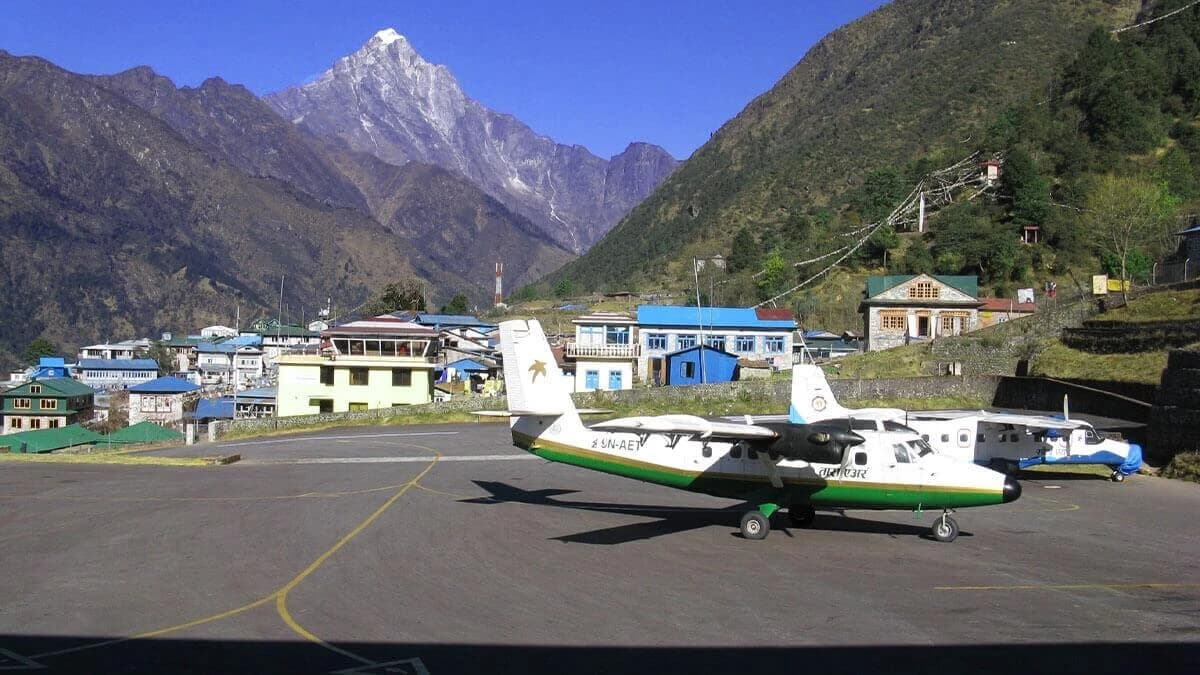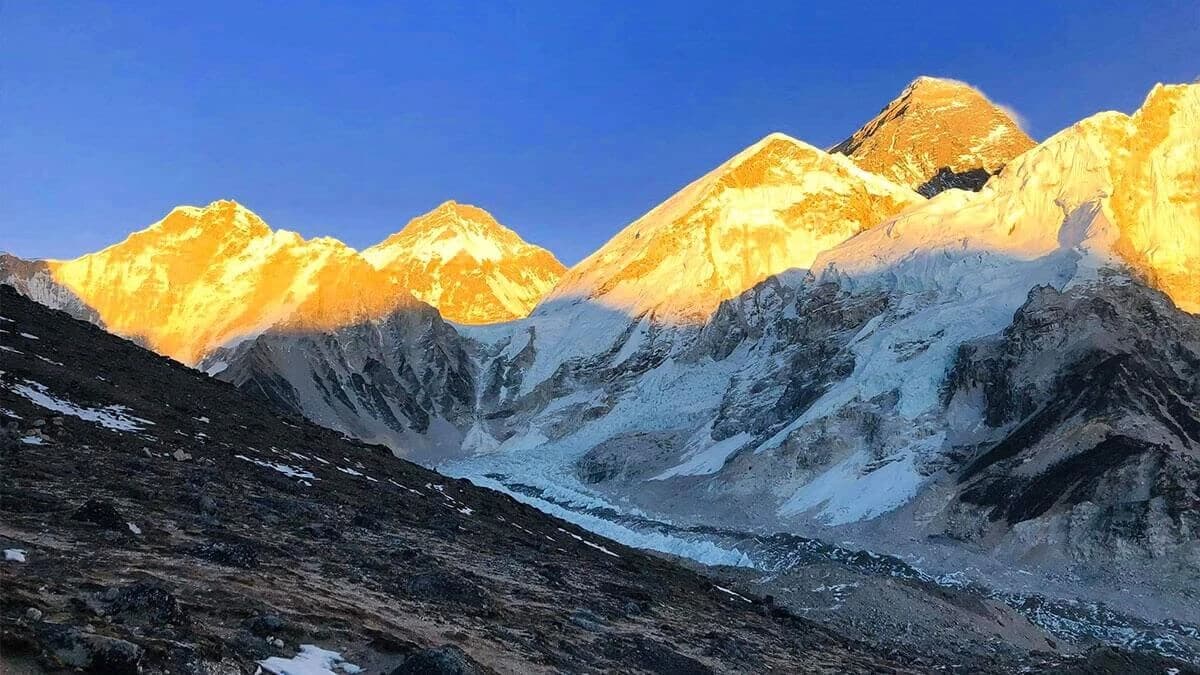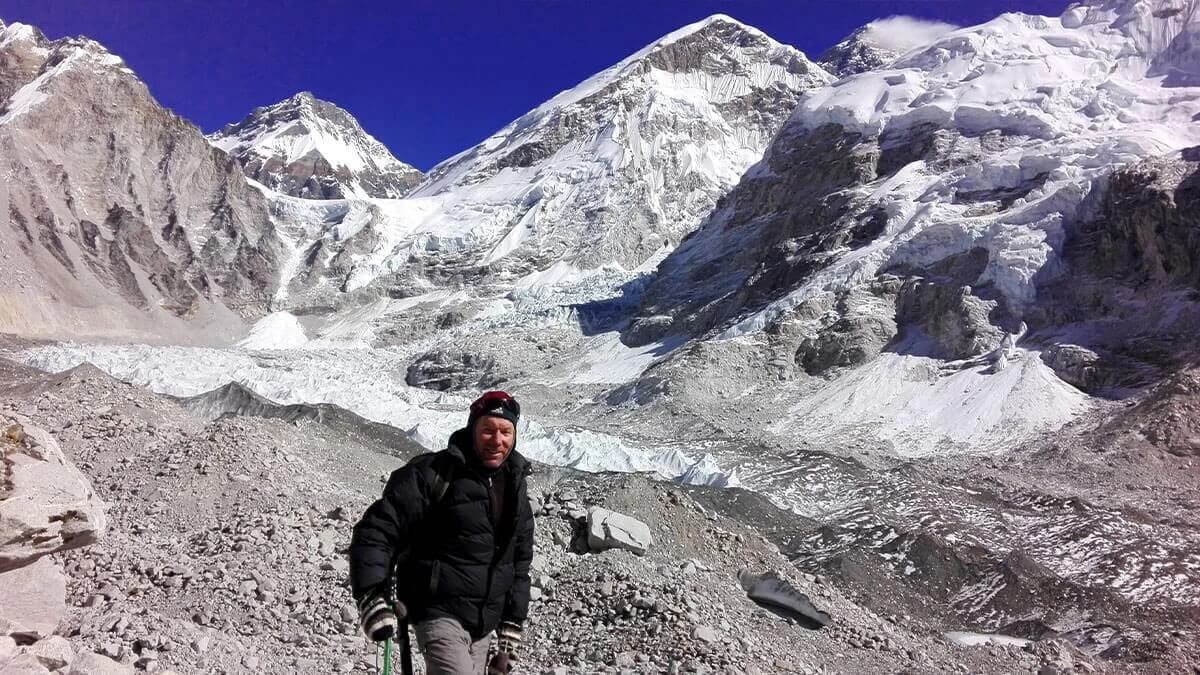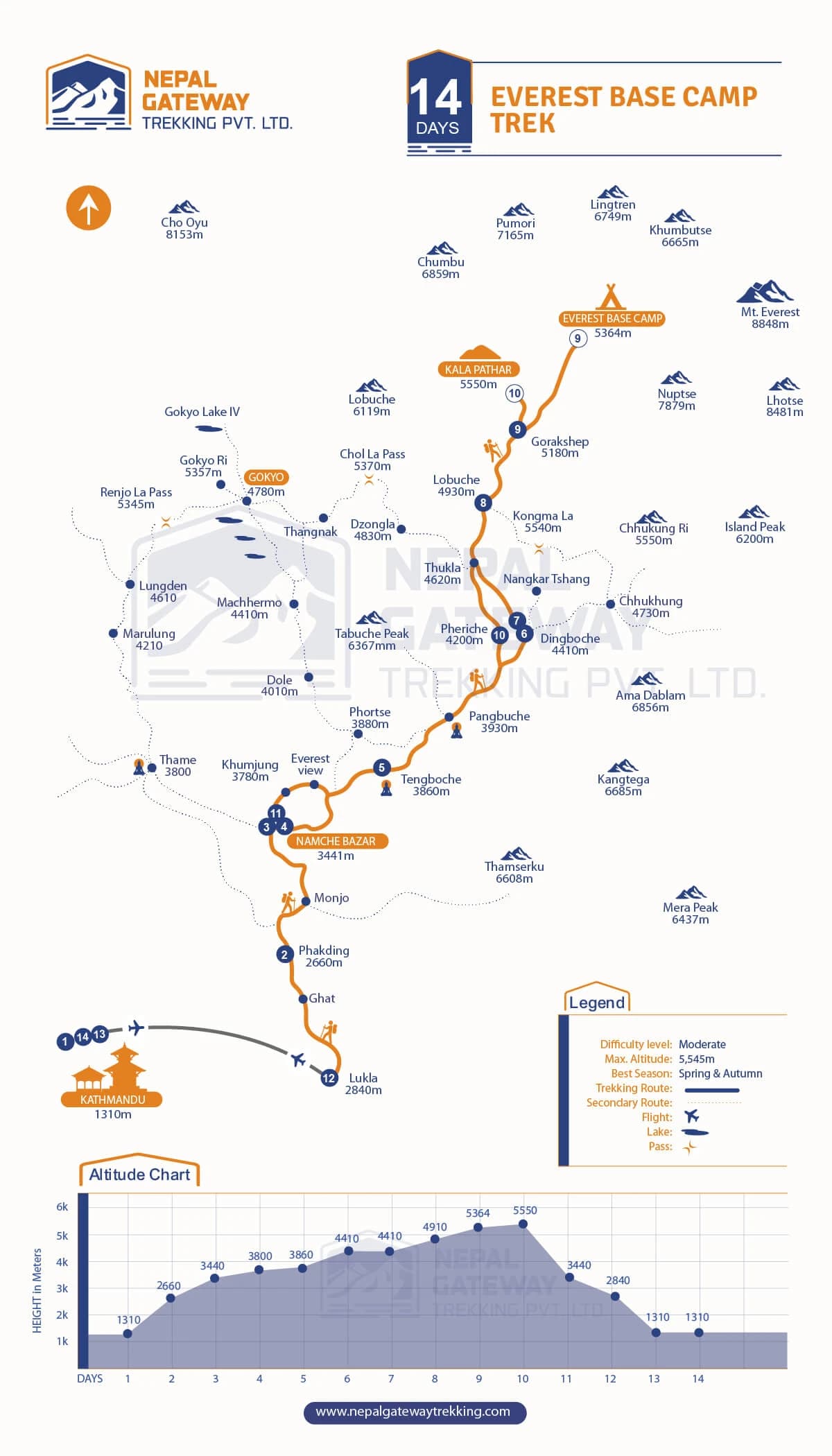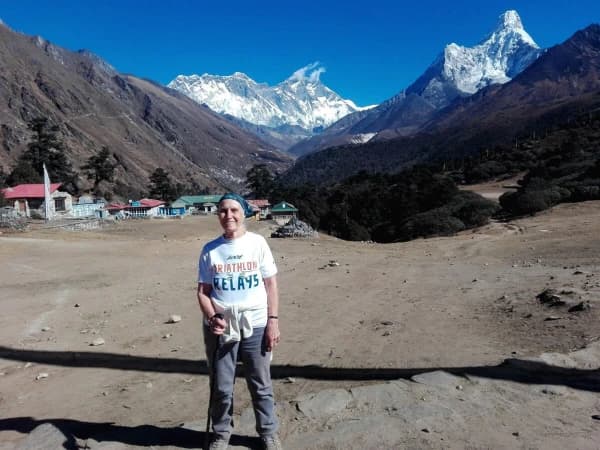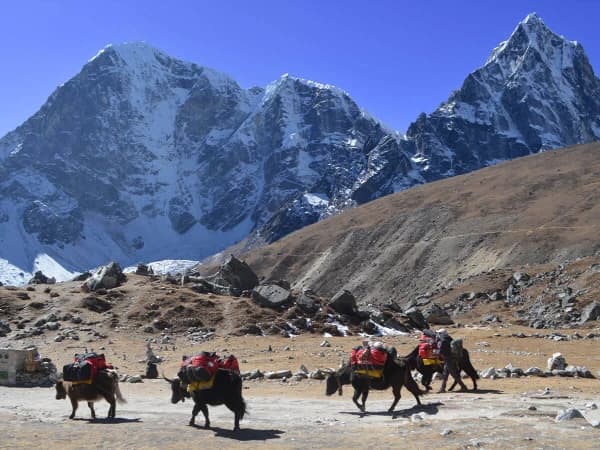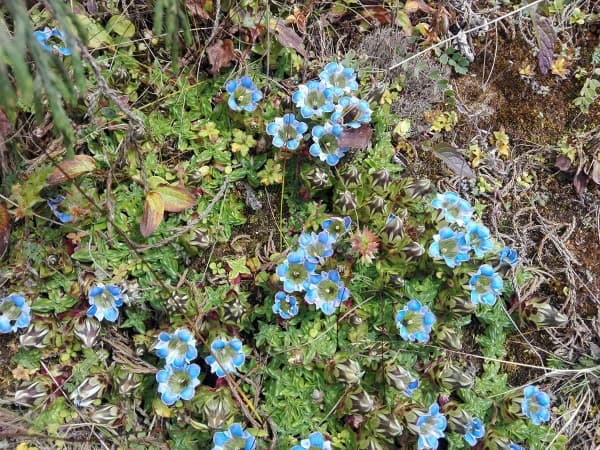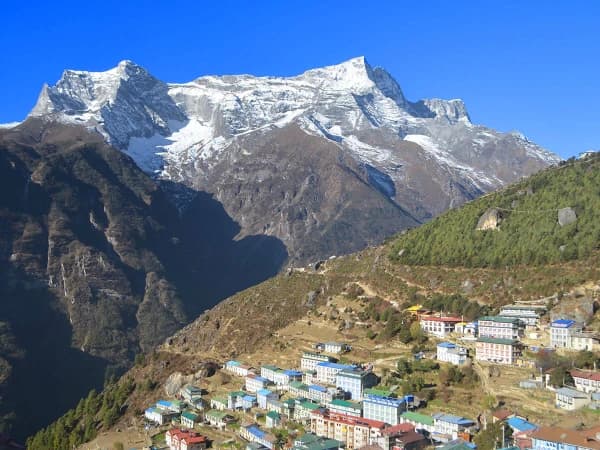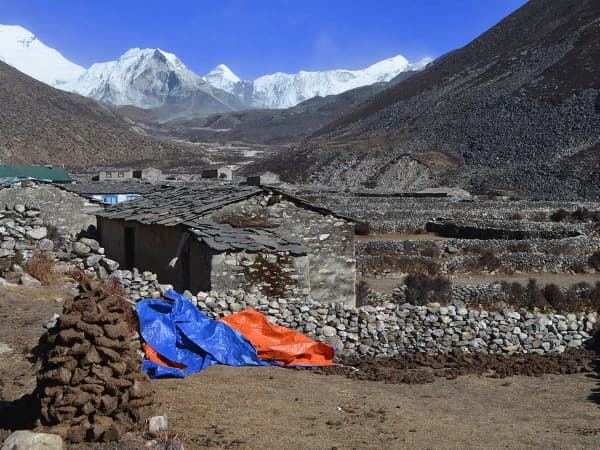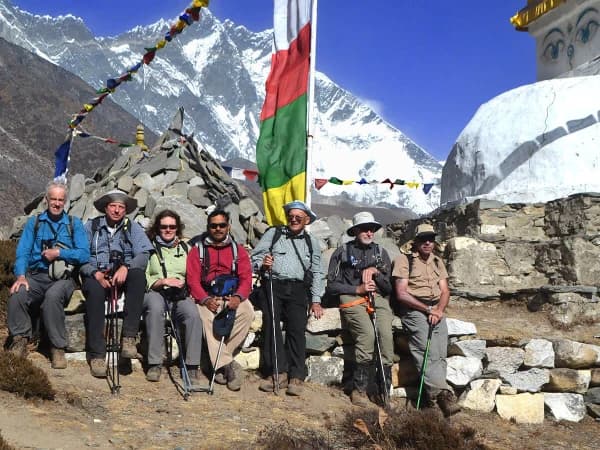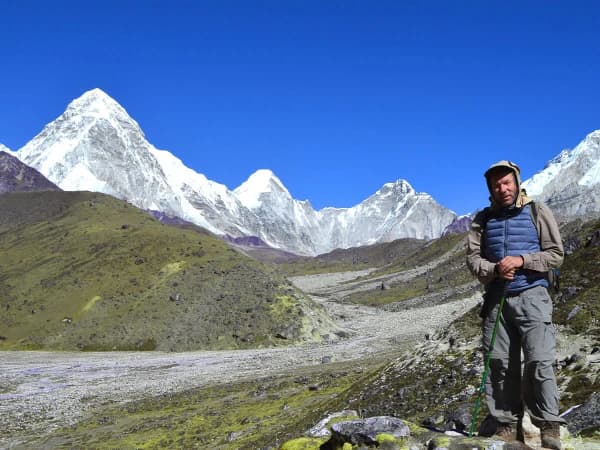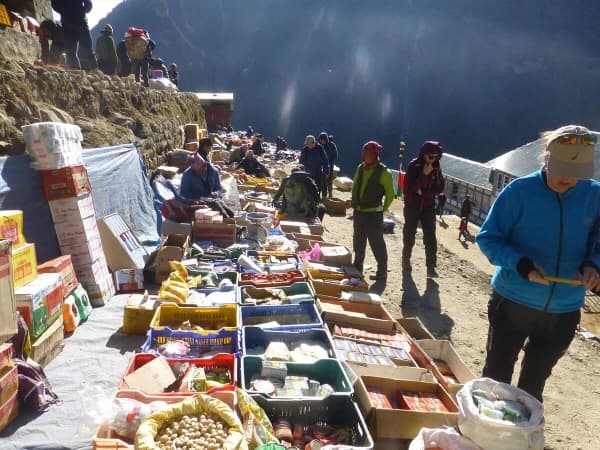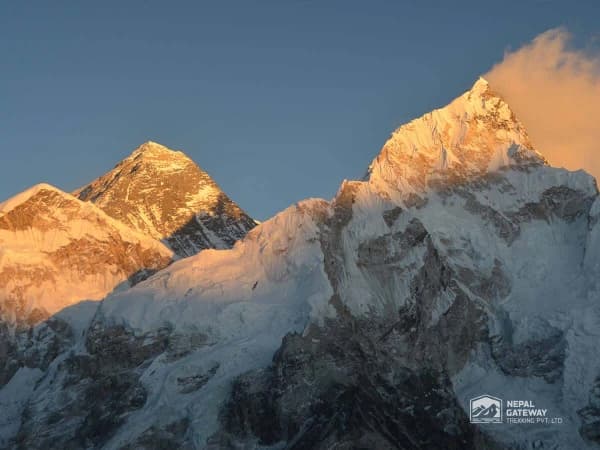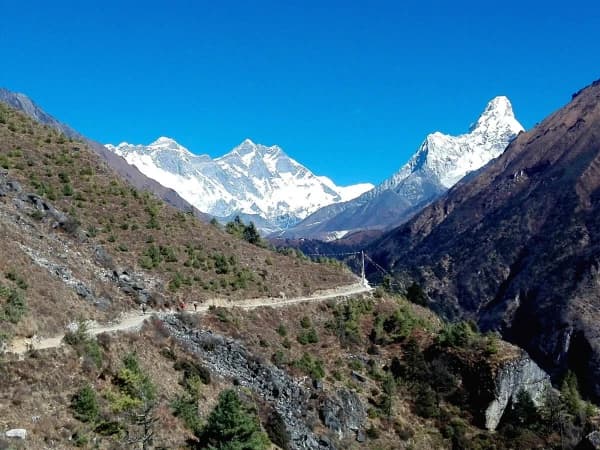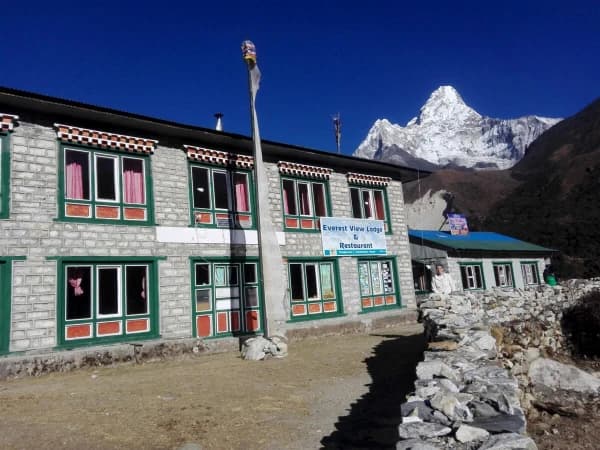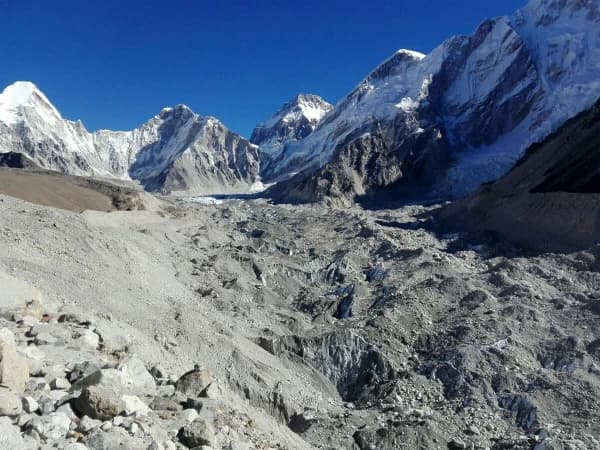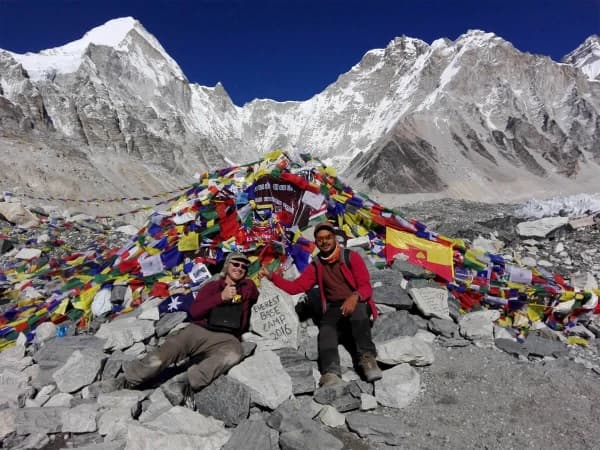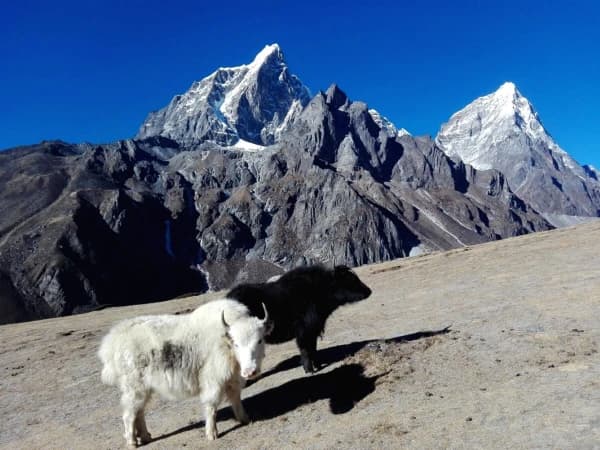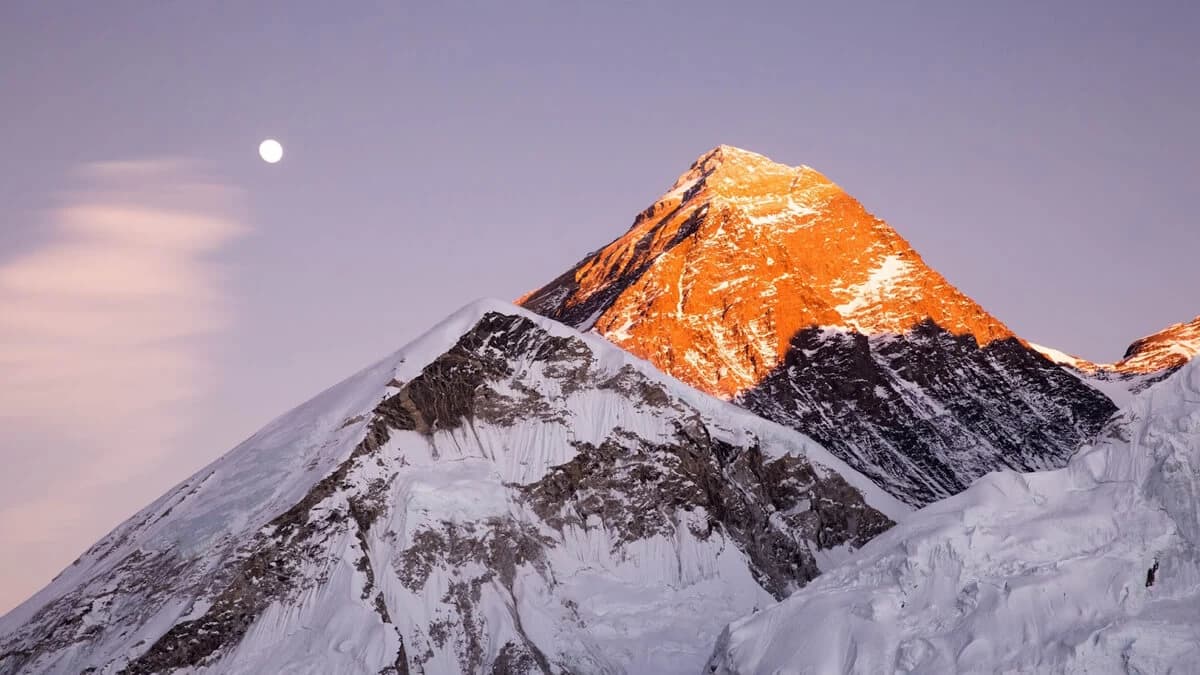Are you dreaming of conquering Everest Base Camp while enhancing spiritual Sherpa culture with spectacular mountain scenery? We are here to help you accomplish your dream of being at the Mount Everest Base Camp.
Everest Base Camp Trek
Everest Base Camp Trek is one of the most famous adventures in Nepal and the world. Tenzing Norgay and Sir Edmund Hillary's first climb of Mount Everest in 1953 brought attention to the iconic trek. The trail to Everest Base Camp is registered on everyone's bucket list. The EBC trek lies in the Solukhumbu district, the eastern part of Nepal.
Many people do this iconic trek within the Sagarmatha National Park every year for lifetime memories. The journey to Everest Base Camp takes about two weeks and starts and ends at Lukla Airport, known for being tricky to land at. Walking through the high mountains, you can learn about the rich culture of the Sherpa people who live in the Everest region.
You'll explore old religious places like chortens, mani walls, and Buddhist monasteries. One famous monastery you'll visit is called Tengboche. You'll also see the best views of Mount Everest (8,848 m), the tallest mountain on Earth.
One of the major EBC trek highlights is climbing Kala Patthar, literally meaning "black rock" (5,545 m). This is the highest point on the trek, where you can witness the summit of Everest and the Khumbu Icefall. Getting to the top of Kala Patthar is a significant accomplishment and something you'll never forget.
Important Note: During the peak season, flights will be operated from Manthali Airport, Ramechhap, to Lukla. In the spring, from mid-March to mid-May and late September to November in autumn, all flights take off and land at Manthali Airport.
The Manthali airport, Ramechhap, is 142 km from Kathmandu, a 4-5 hour drive. To catch a flight to Lukla from Ramechhap, you must depart from Kathmandu from 1 a.m. to 2 a.m.
We highly recommend that you come with at least one more extra day for jet lag, especially considering the early morning drive to Manthali Airport, which benefits from adequate rest and sleep beforehand. And also dont forget to carry Everest Base Camp Trek route map for better trek plan.
Major Highlights of Everest Base Camp Trek
- Thrilling flight to Tenzing Hillary Airport in Lukla, the world's most extreme airport.
- Trek through Sagarmatha National Park, a UNESCO Natural Heritage Site.
- Cross high suspension bridges, including the towering Hillary suspension bridge, the tallest in Nepal.
- Explore the vibrant Sherpa town of Namche Bazaar.
- Walk in the footsteps of legendary mountaineers on the iconic Everest Base Camp trekking trail.
- Visit ancient chortens, mani walls, and the famous Tengboche Monastery.
- Reach the iconic Khumbu Glacier and Everest Base Camp, an emotional milestone of the trek.
- Hike to Kala Patthar, the trek's highest point, for awe-inspiring views of Mount Everest.
- Witness the Khumbu Glacier, the world's highest glacier.
- Relish stunning views of the world's tallest peaks, including Mt. Everest, Mt. Lhotse, and Mt. Makalu.
- Discover the rich cultural heritage of the Solukhumbu region by visiting remote Sherpa villages.
Everest Base Camp Route Overview
Your 14-day EBC trek in Nepal starts after you land at Kathmandu airport. You take a thrilling plane ride to Lukla. Look out the window and see big snowy mountains, green hills, and tiny villages below. When you land in Lukla, your EBC hiking journey begins.
The first-day hike takes you to Phakding, where you'll spend your first night on the EBC trail. In the afternoon, you can do an acclimatization hike to the Pema Choling Monastery, also known as Rimijung Gumba.
The trekking path winds through rhododendron forests and tiny Sherpa settlements like Bengkar and Monjo before reaching Namche Bazaar. Namche Bazaar is known as the gateway to Mount Everest. This bustling Sherpa town is the first acclimatization stop on the trek to Everest base camp.
You'll get several side trip options, with popular ones including a hike to Hotel Everest View. You can also visit the traditional Sherpa villages of Khumjung and Khunde. These acclimatized hikes offer a captivating sight of Mount Everest, Mount Ama Dablam, and its surrounding peaks.
You explore Namche Bazaar, home to notable landmarks like the Sagarmatha National Park Visitor Center. the Sherpa Culture Museum and Namche Bazaar Monastery.
After a well-acclimatized hike at Namche, you continue your hiking journey to the base camp of Mount Everest. Your next destination is Tengboche, home to Tengboche Monastery, the largest in the region. You'll have the chance to observe and gain fascinating cultural insights into the Khumbu region.
The trek continues towards Dingboche, the second popular acclimatization stop on the way to Mount Everest Base Camp. Dingboche is a well-known place for a stunning mountain backdrop. A hike to nearby viewpoints like Nangkartshang Peak (5,083 m) offers panoramic vistas of Mt. Tawache, Ama Dablam, Island Peak, Lhotse, Everest, and Pumori.
After spending a day in Dingboche, it's time to continue hiking to Lobuche. It is a small village and a vital acclimatization stop before the final push to Everest Base Camp.
From here, you'll trek to Gorak Shep, the highest village on the trek. Afterwards, the trail continues alongside the Khumbu Glacier, with the Everest Mountain Range looming behind. Walking along the glacier, the rocky terrain and Sherpa prayer flags lead you toward the famous Everest Base Camp rock.
The journey to Everest Base Camp is physically demanding but deeply rewarding. Reaching the base of the world's tallest peak is an unforgettable experience of your life. You will feel like you are surrounded by towering snowy peaks that leave you in awe. You'll see famous peaks like Nuptse, Lhotse, Pumori, Lobuche, and Changtse.
The next day, you'll climb to Kala Patthar, the highest point of the Mount Everest Base Camp trek at 5,545 m. From the top, you can witness the sunrise panorama over the mighty Himalayan range, including the Everest summit. After soaking in the epic views, the descent back to Lukla begins. First, you'll trek down to Gorak Shep and then continue to Pheriche via Pangboche.
Continuing your return journey, you'll reach Namche Bazaar once again. This time, staying in Namche brings a sense of accomplishment as you celebrate your successful trek to Everest Base Camp. Finally, a long day of hiking brings you back to Lukla. The next morning, you'll catch a flight back to Kathmandu, marking the end of your Everest Base Camp adventure in Nepal.
Still unsure how many days you’ll need for your Everest Base Camp trek?
Message us today, and we’ll help you choose the best route, pace and plan that fits your time and fitness.
Why Choose Nepal Gateway Trekking for Everest Base Camp Trek?
Your Adventure, Our Expertise!
At Nepal Gateway Trekking, we are dedicated to providing exceptional Himalayan experiences tailored to your unique needs. Here’s why we’re the ideal choice for your Everest Base Camp Trek adventure:
- Experienced and Qualified Guides: Our guides are government-certified, English-speaking, and friendly. They are very knowledgeable about the trails and trained in first aid and altitude sickness prevention.
- Safety and Well-being First: Your safety isn't just important to us; it's our number one priority. We adhere to strict safety rules and provide comprehensive insurance coverage for our guides and porters.
- Local Expertise and Personalized Service: Our team of local experts has over two decades of experience in the Himalayas. We always dedicate ourselves to providing personalized service and ensuring your adventure is tailor-made to your specific interests.
- Competitive Pricing and Quality Service: We offer competitive rates without compromising quality. Our goal is to provide exceptional value for your investment.
- Tailored Gear and Itinerary: We carefully curate your trekking gear and itinerary based on your specific needs and preferences. We are ensuring a comfortable and enjoyable journey.
- Flexible Plans for Lukla Flights: We’ve developed contingency plans to accommodate potential flight delays or cancellations, ensuring your adventure isn’t disrupted.
- 24/7 Customer Support: We are here to assist you every step of the way. Our dedicated customer support team is available 24/7 to answer your questions, address your concerns, and provide personalized assistance.
Itinerary
This is our standard and recommended Everest Base Camp Trek itinerary.
Welcome to Kathmandu, Nepal's vibrant capital! Upon landing at Kathmandu International Airport, a friendly representative from Nepal Gateway Trekking will greet you. After finishing the airport formalities, you'll be transferred to your hotel to relax and freshen up. Take the rest of the day to explore the local area at your leisure.
In the evening, join your guide for a trip briefing. Discuss the 14-day Everest base camp trekking itinerary and ask any questions. Afterwards, prepare for your Everest base camp trek. If you need trekking gear, Thamel is a great place to shop. Pack your backpack and get a good night's rest.
Your Mount Everest base camp trek begins with an early morning flight from Kathmandu to Lukla. After breakfast, you'll head to the domestic terminal of Kathmandu International Airport.
Flights to Lukla usually depart in the early morning, either from Kathmandu Airport or Ramechhap Airport. It's safer to fly in the morning because the afternoon weather in the Everest region often becomes windy.
Once you land at Tenzing Hillary Airport in Lukla, you'll meet your porters and the rest of the trekking crew. After making final preparations, begin your trek towards Phakding. This short, mostly downhill hike is an excellent way to warm up and adjust to the altitude.
The trail winds through the Dudh Koshi Valley, where you'll see mani stones, prayer wheels, and small hamlets. You'll also cross suspension bridges over the Dudh Koshi River and its branches. As you walk, you'll pass through Chheplung village, which offers a mesmerizing sight of Mt. Khumbila, a scared peak that has never been climbed.
From Chheplung, continue downhill until you reach Phakding. After settling into your teahouse and taking a brief rest, you can visit a nearby monastery to experience the local culture.
Important Note: During the peak season, flights will be operated from Manthali Airport, Ramechhap, to Lukla. In the spring, from mid-March to mid-May and late September to November in the autumn season, all flights take off and land at Manthali Airport.
The Manthali airport, Ramechhap, is 142 km from Kathmandu, a 4-5 hour drive. To catch a flight to Lukla from Ramechhap, you must depart around 1 a.m. to 2 a.m. from Kathmandu.
Shortly after leaving Phakding, you'll cross the Dudh Koshi River and follow a steady, undulating path on the west side. Today's route is slightly longer and more challenging than yesterday's.
The trail leads you through mountainside forests and the small villages of Tok Tok and Bengkar. As you continue walking, you'll pass through Monjo and reach the entry point of Sagarmatha National Park. All your Everest base camp trekking permits will be checked and verified here.
Enjoy the distant snow-capped mountains as you walk on the famous EBC trekking route. One of the major highlights of the EBC hike is crossing numerous suspension bridges adorned with tattered prayer flags. The most interesting is the highest and longest—the Hillary Bridge.
The next stop is Jorsalle village. Remember that the climb gets tougher after crossing your last suspension bridge for the day. The path becomes steeper and zigzag. After a while, you'll reach a viewpoint where you get your first glimpse of Mount Everest—massive, dramatic, and snowcapped. The scenery becomes even more spectacular as you trek and gain altitude.
You'll conclude your day's trek as you reach the Namche Bazaar Check Point. Namche is an authentic Sherpa town nestled in the mountains. The village streets are lined with outdoor gear shops and pharmacies, and you'll see fellow trekkers resting in the cafes and restaurants.
Namche Bazaar is your first stop to acclimate along the Everest base camp trekking route. It's essential to give your body time to adjust to the lower oxygen levels.
You can begin with a morning hike to the Hotel Everest View to acclimatize. This hotel, one of the highest placed in the Himalayas at 13,000 feet, offers majestic 360-degree panoramas of the awe-inspiring peaks, including Mt. Everest. Next, you can hike up to the airstrip at Syangboche for a clearer view of Everest, Lhotse, and Ama Dablam. From this vantage point, you'll also get a sweeping view of Namche Bazaar below.
Further, there is another popular hiking option to the traditional Sherpa villages of Khumjung and Khunde. These villages are less touristy than Namche because they're not on the main EBC trail. The hike to these villages is also a great way to help with acclimatization.
These serene settlements offer spectacular mountain scenery and notable landmarks. Khumjung is famous for its green-roofed houses, the Khumjung (or Hillary) School, and the Khumjung Monastery, which is said to have a yeti scalp. In Khunde, you can visit the Khunde Hospital, built by legendary Sir Edmund Hillary.
If you are not up for a long hike, you can still explore Namche Bazaar. There's plenty to see and do, including Namche Bazaar Monastery, Sherpa Culture Museum, and more. Plus, there are many cafes, pubs, and restaurants where you can relax and recharge for the rest of your trek.
After spending two incredible nights at Namche Bazaar, you trek towards Tenbgoche village. The trail offers sensational scenes of the Everest Mountain range. This trekking route from Namche to Tengboche is one of the most scenic parts of the EBC hike.
You'll begin your trek on a well-maintained path that gradually climbs out of the village and heads northeast. The trail gently rises, crossing the spectacular hillside east of Khumjung and leading to Khyangjuma (Kenjoma). From here, the sight of Ama Dablam is jaw-dropping.
From Khyangjuma, the trail descends steeply to Phunke Tenga, where you'll cross the rushing Dudh Koshi River on a suspension bridge. After crossing, you'll face a long, steady climb up to the world-famous Tengboche Monastery. The monastery is high on a ridge and offers grand 360-degree views of Ama Dablam, Kangtega, Thamserku, Lhotse, and Everest.
You'll reach Tengboche Monastery, one of the Khumbu region's largest and most significant monasteries. It is a major Buddhist centre where you can receive blessings from the lama, who chants Buddhist prayers. You can also attend puja ceremonies organized by monks, which are open to trekkers at 6 am and 3 pm.
Starting your trek from Tengboche, after a 20-minute walk, you'll reach the small settlement of Deboche. During peak trekking seasons, finding accommodation in Tengboche can be difficult, so many trekkers continue to Deboche to secure a place to stay.
From Deboche, the walk descends to Pangboche, where you'll navigate several suspension bridges. Pangboche is a typical farm village known for its cultivation in the area. From here, you can spot various massive mountains up close. After a gentle ascent and crossing the tree line, the final stretch will lead you to Somare, where few trees are visible.
Get your camera ready because the Himalayan giants might appear at any moment. The final walk from Somare to Dingboche offers unobstructed vistas of mighty peaks like Ama Dablam, Nuptse, and Lhotse. Once you reach Dingboche, you'll see additional peaks like Island Peak and Peak 38.
Dingboche is a relatively large settlement surrounded by farmland. The town is particularly stunning in the spring when the fields are full of buckwheat, potatoes, turnips, and green leafy vegetables.
After Namche, Dingboche is another essential acclimatization stop along the EBC trek route. The village's altitude, combined with its astonishing surroundings, creates the perfect environment for acclimatization.
For those seeking an adventurous hike during their acclimatization day, Nangkartshang Peak is an excellent option. The trail to this peak is steep and rugged and follows a winding, sandy path above the valley. Reaching the summit at 5,083 meters, you'll be rewarded with sweeping vistas, including towering mountains, glaciers, rivers, and distant settlements.
From the top of Nangkartshang, you can relish the breathtaking sights of several iconic peaks, including Makalu, Cho Oyu, Lhotse, Ama Dablam, and Island Peak, as well as the magnificent Imja Glacier. While the hike is challenging, it's a rewarding experience that offers incredible scenery and helps with acclimatization.
Thus, this hike prepares you to tackle the higher altitudes in the epic journey ahead.
If you prefer a less demanding option, a trek to Chhukung village in the Imja Valley is another excellent choice. This small, scenic village allows you to gaze up at the colossal south face of Lhotse and immerse yourself in the region's dramatic landscapes.
After a rest day in Dingboche, it's time to return to the EBC trail. Today, you head to Lobuche, with just one day left until you reach Everest Base Camp—one of the main highlights of the EBC trekking itinerary.
You'll start by heading northwest, above the village of Pheriche. The trek path will take you to the tiny settlement of Dughla/Thukla. From here, you'll get the most staggering view of Ama Dablam. Take a moment to appreciate the breathtaking panorama.
From Dughla, you'll follow a zigzag path northwards, walking on the moraine of the magnificent Khumbu Glacier. Even though the climb is short, you'll feel your heart racing as you'll be at an altitude of over 5,000 meters.
Finally, this arduous climb ends at the dramatic Thokla Pass. This pass is poignant, as it's filled with memorials to climbers who have lost their lives in the Everest region. You might recognize some of the names in the memorial, as you've heard of their courageous attempts to climb the world's tallest peak.
After a moment of reflection and prayer for the departed souls, you'll continue your journey to Lobuche. Beyond the Thokla Pass, the landscape becomes more rugged and barren. You'll follow the path next to the glacial moraine for about an hour before reaching Lobuche.
Lobcuhe is one of the finest villages in Khumbu and welcomes you to captivating views of various mountains, including Nuptse, Changri, and Pumori.
Today is the day you've been waiting for. You'll walk to Everest Base Camp, where many climbers start their journey to the top of Mount Everest. You start early from Lobuche. The path is rocky and winds between giant boulders. As you walk, you'll see the landscape change. There are fewer plants, and the ground is mostly rocks and ice. The air gets thinner, making each step harder.
After about two hours of walking, you reach Gorak Shep. This small village has a few simple lodges. It's the last place to stay before base camp. Here, you need to be extra careful about altitude sickness. Drink lots of water, even if you're not thirsty. Eat light meals and rest for a bit.
Next comes the exciting part—the hike to Everest Base Camp. The trail from Gorak Shep is marked with stone piles called cairns. You'll walk on a path that goes up and down over rocky ground and patches of snow. Sometimes, you might need to use your hands to help you climb over big rocks.
Finally, you reach Mount Everest Base Camp. It's not just one spot but a large area on the glacier. During the climbing season, you'll see many tents of different colours. Climbers stay here while preparing for their Everest climbing. At base camp, you can see lofty, snowy peaks around you. Take some time to enjoy this unique view.
After spending some time at base camp, you'll return to Gorak Shep. Remember to rest well because the thin air at this height can tire you more quickly.
Today, you'll hike to Kala Patthar, the highest point of the classic EBC hike near Gorak Shep. From here, you'll get the unobstructed sight of Mt. Everest. The Kala Patthar hike is part of the EBC trekking. It's an arduous climb up steep, rocky ground.
You need to start very early before the sun comes up. This way, you can see the first ray of sun falling on Everest. The path is easy to follow, but you should walk slowly. The thin air at this height makes walking harder. Take lots of breaks to catch your breath and enjoy the beautiful scenery.
When you get to the top, the dramatic vista is incredible. You can see mountains all around you. Everest, Lhotse, and Pumori are prominent peaks you'll see. Take a few minutes to enjoy this fantastic scene. Then, you'll head back down to Gorak Shep.
After a quick breakfast, you'll walk back to Pheriche. You'll go the same way you came. On the way, you'll pass through the towns of Lobuche and Thukla again. You'll also cross the Thokla Pass. Here, the path splits, and you'll take the way to Pheriche. As you go down, you'll notice the dramatic changes in the landscape and the climate.
Today, you'll trek from Pheriche to Namche Bazaar. Even though you'll pass through some of the same settlements as before, it's still fun to see them again. The familiar route still offers breathtaking landscapes, from lush forests to rocky high-altitude terrain.
You'll walk through beautiful rhododendron forests. The path also takes you over hanging suspension bridges above the fast-flowing Dudh Koshi River. You can see lovely waterfalls from these bridges. As the trek progresses, you come across several traditional Sherpa settlements of Somare, Pangboche, Deboche, and Tengboche.
At the end, you'll reach the busy town of Namche Bazaar. To celebrate your successful accomplishment of the EBC trek, you can visit a nice bar and enjoy a beer or wine.
Today is the last day of your Everest base camp trek in Nepal. You'll walk back to Lukla, following the same path you took before. Climbing to Namche Bazaar from Lukla was tough, but returning will be easier.
You'll begin by descending to the Hillary Bridge, following a zigzag path. After crossing the bridge, you can enjoy the picturesque scenery and the sound of rushing water below. As you get closer to Lukla, the trail becomes steeper and rockier. Finally, you'll reach Lukla, where your EBC hike ends.
After breakfast, you'll go to Tenzing Hillary Airport. This is where you'll take your flight back to Kathmandu. You can enjoy the beautiful mountains one last time. As you get on the plane, you'll see the snowy peaks getting bigger and bigger.
You'll land at Kathmandu International Airport. Then, you'll drive to your hotel. Check in and relax for a while. You can explore the nearby areas and buy souvenirs as a memory of your trip. In the evening, you can go to Thamel, a famous place in Kathmandu, to experience the nightlife.
On your last day in Nepal, enjoy some free time to explore nearby areas and shops for souvenirs. A representative from Nepal Gateway Trekking will escort you to the airport for your departure flight.
If you wish to extend your stay, we offer various trekking and tour packages in Nepal, Bhutan, and Tibet. Contact us for more information on prolonging your adventure in the Himalayas.
Dates & Availability
Private tripCost Includes
- All grounded airports pick up and drop off by private vehicle.
- Two nights’ accommodation at a three-star category hotel in Kathmandu, including breakfast.
- Round-trip flight tickets (Kathmandu/Lukla/Kathmandu or Ramechhap/Lukla/Ramechhap), including domestic airport taxes.
- Three meals a day (breakfast, lunch, and dinner) on the EBC Trek.
- All accommodations are in teahouses (twin sharing common room) during the trek.
- One highly experienced, English-speaking, government-licensed, friendly trekking guide.
- Required porters (1 porter between 2 trekkers). A porter is not included for 1 person.
- Sagarmatha National Park permit.
- Local government permit (Pasang Lhamu Rural Municipality Permit).
- Everest Base Camp Trekking Map.
- Nepal Gateway Company T-Shirt.
- Nepal Gateway Company duffel bag for trekking.
- Local fresh fruits, which are served as a dessert after your dinner.
- First aid kit with oximeter to check the oxygen level and heartbeats on the trek.
- Evacuation assistance if it is needed.
- Government taxes.
- Office service charge.
Cost Excludes
- Lunches and dinners in Kathmandu.
- Travel Medical Insurance (Compulsory).
- Nepal Visa.
- Your international flight ticket to/from Kathmandu.
- Your personal nature expenses, equipment, and medical kit.
- All kinds of hot drinks (tea/coffee/hot water) on the EBC trek.
- All kinds of cold drinks (water, Fanta, and Coke) and alcoholic beverages during the EBC Trek.
- Hot shower, internet, and phone call unless it is free.
- Battery charging fees for any electronic devices such as cameras, mobile, laptops, etc.
- Snacks and desserts (cakes, pies, chocolate pies, etc.).
- Tipping to field staff (tipping is not mandatory but expected).
- Extra accommodations in Kathmandu.
Good To Know
Lukla Flight Information
Lukla is the starting point for the Mount Everest Base Camp Trek. While there are several ways to reach the trailhead, flying from Kathmandu is the most popular option. However, the flights no longer operate from Kathmandu Airport in the peak season i.e. Spring and Autumn.
The flights will be operating from Manthali Airport to Lukla. From the second week of March till May in spring and from the last week of September to the end of November in autumn. This change is implemented to reduce air traffic congestion and allow for runway maintenance in Kathmandu.
To reach Lukla during peak periods, you must make a road trip from Kathmandu to Ramechhap. It takes about 4 to 5 hours, depending on road conditions and traffic. From Manthali airport, flights to Lukla are brief, lasting only 18 to 20 minutes. These flights are less prone to cancellations or delays due to weather conditions than those departing from Kathmandu.
In case of a flight cancellation from Manthali airport, basic lodges and hotels offer the accommodation until flights resume. For those seeking an alternative, helicopter flights are available, though more expensive. They provide greater reliability and flexibility in adverse weather conditions.
It’s important to note that Lukla flights are in high demand and fill up quickly, especially during peak trekking seasons. To avoid complications, it’s advisable to book early and plan your schedule with some buffer days to accommodate potential flight delays or cancellations. The latest flight status updates is essential for a smooth journey to the start of your Everest adventure.
Cost for the Everest Base Camp Trek
The cost for the Everest base camp trek can vary depending on several factors. Such as the number of travelers, trek duration, trekking season, and the services you choose. Typically, the EBC trek price ranges from $1420.00.
This cost generally covers trekking permits, round-trip domestic flights between Kathmandu to Lukla. It includes professional guide and porter, accommodation, and meals (breakfast, lunch, and dinner) during the trek.
Tips for Budget Trip to Everest Base Camp Trek
- Bring snacks and water purifying tablets to save on teahouse meals and bottled water.
- If you are trekking in a group, share the cost of guides and porters.
- Minimize unnecessary spending by choosing standard, healthy meals and basic accommodations.
- Book flights and accommodation in advance to secure better deals.
- Rent trekking gear in Kathmandu, as prices in Lukla or Namche are generally higher.
If you're looking for a more luxurious trip to Everest base camp, the cost is much higher than standard package. Check our Everest Base Camp Heli Trek.
Everest Base Camp Trek Cost Breakdown
The cost of the Everest Base Camp Trek is determined by the number of participants in your group. The larger the group, the lower the cost per person, making it an affordable alternative for friends, families, and trekking groups. The detailed pricing structure is as follows:
- USD 1420 per person for solo trekkers (1 person)
- USD 1340 per person for small groups of 2 to 4 people
- USD 1300 per person for medium groups of 5 to 10 people
- USD 1270 per person for larger groups of 11 to 16 people
Choosing to trek as a group not only reduces the individual cost but also enhances the overall experience through shared moments and support on the trail. Whether you're planning a solo challenge or a group expedition, this flexible pricing ensures value for every type of traveler.
When is the Best Time for Everest Base Camp Trek?
The best time to trek to the Everest Base Camp is Spring (March to May) and Autumn (September to November). Although you can go for an EBC hike all year around. In spring, daytime temperatures range from 5°C to 15°C at lower altitudes, with nights being colder as you ascend. The weather is pleasant, and the rhododendron forests are in full bloom, adding vibrant colors to the landscape.
During autumn, temperatures are cooler, ranging from 5°C to 12°C during the day. This season offers clear skies, remarkable mountain scenery, and stable weather, making it an ideal season for trekking. However, both seasons are also the most popular, meaning the EBC trail is crowded with trekkers. So it's essential to book the flights and accommodations well in advance.
Nonetheless, EBC Trekking in winter (December to February) and the monsoon (June to August) is still possible. But there are additional challenges. In winter, temperatures can drop to -15°C or lower at higher altitudes, and snow may block some trails.
Monsoon brings heavy rains, making the path muddy and increasing the risk of landslides. Trekking during these off-seasons requires thorough preparations for weather complications. However, it offers quieter trails and more solitude.
How difficult is the Everest Base Camp Trek?
While challenging, the Everest Base Camp trek is manageable for those with moderate fitness and determination. Unlike other off-beaten treks in Nepal, the EBC hike is not as daunting as one might think, but it still requires effort. The trek is long, with high altitude, rugged terrain, and unpredictable weather, making it a real test.
The EBC trek distance covers approximately 130 kilometers from Lukla to the base camp and back. Trails range from rough and rocky paths to steep and uneven sections. Although the paths are generally well-marked, the long trekking days and challenging terrain require physical endurance and mental strength.
High altitude poses a significant challenge. Starting at 2,800 meters in Lukla, hikers climb to 5,364 meters at Everest Base Camp. This increases the risk of altitude sickness. Proper acclimatization is crucial; check with a doctor for health issues.
Weather adds to the difficulty of the Everest base camp trek. Spring and autumn offer the best conditions, with mild temperatures and clear skies. Monsoon season brings slippery, dangerous trails due to heavy rain. Winter has freezing temps, and winds can reach speeds of over 285 km/hr.
The EBC trek is moderately complex and typically takes two weeks through diverse landscapes. The difficulty also depends on the trekkers' fitness levels. The EBC trekking is considered medium to strenuous for those with medium to good fitness. Despite these challenges, with proper planning and preparation, reaching Everest Base Camp is an achievable and unforgettable adventure for many trekkers.
Training for Everest Base Camp Trek
Before starting your EBC journey, proper planning and preparation is essential. Training for the trek to Mount Everest Base Camp helps you build the strength and endurance needed for the rugged trails and high altitudes. However, there's no need to go to extremes.
Cardio exercises like running, cycling, or swimming can help build your endurance. These activities improve your stamina, which is essential for long trekking days at high altitudes. Next, strength training is also important for EBC trek preparation.
Focus on exercises for your legs, back, and core. Strong muscles will help you carry your backpack and handle the mountainous terrain. Strengthening your limbs and forearms will also be helpful during the trek.
If possible, we advise you to training at high altitudes. It will help your body to used to lower oxygen levels. If you are a beginner, try doing a few hikes or treks before the EBC journey. You can come to Nepal a few days earlier and do short treks to adjust to the altitude and long walking hours.
For the EBC hike, mental preparation is just as important as physical training. Familiarize yourself with the challenges of the trek, including the terrain, altitude, and weather. Cultivating a positive mindset can significantly improve your overall trekking experience.
It's advisable to train a few months before your trek to build your fitness gradually. Aim for consistency in your routine by mixing cardio, strength exercises, and hiking to prepare your body entirely.
What Permits are Required for the Everest Base Camp Trek?
You need two main trekking permits for the Everest Base Camp tre .
1. Sagarmatha National Park Entry Permit
- Required for entering the Everest Region
- Supports conservation efforts in the park
2. Khumbu Pasang Lhamu Rural Municipality Permit
- New permit introduced by local authorities
- Supports local development and tourism management
Important Note: A TIMS card is not compulsory now. But the Khumbu Pasang Lhamu Rural Municipality Permit is now compulsory. For further details, you can contact us.
Key points about Everest Base Camp Trek permits
- TIMS and Sagarmatha National Park permits are obtainable in Kathmandu
- Khumbu Municipality permit is issued in Lukla or Monjo
- Fees vary for foreign nationals, SAARC country citizens, and Nepali nationals
- All permits must be carried throughout the trek and shown at checkpoints
- Trekking agencies often handle permit arrangements for guided treks
- Independent trekkers can obtain permits themselves with proper documentation
- Penalties apply for trekking without valid permits
Everest Base Camp Trek Route Variation
There are several route variations of the Everest base camp trek, each offering unique experiences that further enrich the journey through the Everest region.
Gokyo Lake Trek
The Everest base camp via the Gokyo Valley Trek is a popular variation among the trekkers. Starting from Lukla, the trek follows the same path to Namche Bazaar before branching off to the northwest. The trail proceeds through the lesser-known villages of Dhole and Machhermo, eventually reaching the serene Gokyo Lakes.
From Gokyo, trekkers summit Gokyo Ri Peak for panoramic views, including the magnificent Ngozumpa Glacier. The route to and from Gokyo Lakes offers a quieter and more serene experience than the main ebc trail.
Everest Three Passes Trek
The Everest Three Passes Trek is an adventurous addition to the classic EBC trek route. Starting from Lukla, this challenging circuit takes trekkers through the heart of the Everest region, crossing three high-altitude passes: Renjo La, Cho La, and Kongma La.
Hikers experience diverse landscapes, from the turquoise Gokyo Lakes to the iconic Everest Base Camp. Along the way, they ascend Kala Patthar and Chukkung Ri for panoramic mountain vistas. This trek offers a comprehensive Himalayan experience, showcasing the region's dramatic peaks, remote villages, and pristine alpine environments before concluding in Lukla.
Everest Base Camp Trek with Helicopter Return
The Everest Base Camp Heli Trek combines the full trekking experience with a quicker way back. You hike the traditional route from Lukla to Everest Base Camp, visiting key villages and climbing Kala Patthar. Instead of walking back, you fly by helicopter.
This option is ideal for those with limited time or who want a less demanding return journey. It offers the best of both worlds – a complete trek up with splendid ground-level views and a fast, scenic flight back. This mix of adventure and convenience allows you to fully experience Everest while saving time and energy on the return trip.
Jiri to Everest Base Camp
This Jiri to Everest Base Camp Trek offers an alternative to the standard route, starting with a Lukla flight. Instead, this journey begins with a 9-hour bus ride from Kathmandu to Jiri. Trekkers embark on a 5 to 6-day hike through the Solukhumbu region before reaching Lukla.
This additional leg of the journey allows travelers to experience more of the local culture and landscape. Once in Lukla, the trek follows the same path as the standard Everest base camp route. While this variation adds extra days to the trip, it provides a unique and more comprehensive trekking experience in the Everest region.
Altitude sickness
Altitude sickness, or Acute Mountain Sickness (AMS), is a common concern during the EBC trek. It occurs when your body struggles to adjust to the lower oxygen levels at higher altitudes. The chance of getting altitude sickness increases when you trek above 3,000m.
On the EBC hike, you'll reach an altitude over 5,000m, with higher risk. Symptoms often appear after reaching Namche Bazaar (3,440m) and can worse as you go higher. Many trekkers get sick especially around Dingboche (4,410m), Lobuche (4,930m), and Gorak Shep (5,170m).
Common Symptoms of altitude sickness include
- Headache
- Dizziness
- Nausea or vomiting
- Shortness of breath
- Fatigue or weakness
- Loss of appetite
- Difficulty sleeping
In severe cases, symptoms can escalate to
- Confusion
- Coughing up fluid
- Bluish skin or lips
- Inability to walk in a straight line
How to Deal with Altitude Sickness?
Acclimatization is one of the best ways to prevent altitude sickness in the Everest base camp trek. Most EBC trek itineraries include rest days in places like Namche Bazaar or Dingboche. These stops give your body time to adjust to the altitude.
Drink plenty of water to stay hydrated. Dehydration can make symptoms worse.
Avoid rushing and ascend slowly. A steady pace is crucial when trekking at high altitudes. The standard rule is to climb 300-500 meters daily once you are above 3,000m.
You can take preventive medicine like Diamox, which helps your body adjust to altitude faster. However, it's essential to consult a doctor before taking any medication.
If you start feeling any symptoms of altitude sickness, then immediately inform your guide, and if symptoms persist, descend to a lower altitude.
By taking precautions and being aware of the symptoms, you can manage altitude sickness effectively and enjoy your Everest base camp trek safely.
Travel Insurance
For high-altitude treks like Everest Base Camp, having travel insurance is mandatory. It safeguards you against unexpected events such as unpredictable weather, medical emergencies, or trip interruptions.
EBC trekking route takes you to remote areas with limited medical facilities. If you suffer an injury, illness, or altitude sickness, trekking insurance can cover the costs of medical treatment. In case of a severe injury or altitude-related issues, air evacuation by helicopter may be necessary. This service can be costly, but trekking insurance usually covers the high costs of helicopter rescues.
Lukla flight delays or cancellations are common due to weather conditions. If your EBC journey gets interrupted due to weather issues, natural disasters, or personal emergencies, insurance can help recover the costs for cancelled bookings, flights, or accommodations. It may even cover lost, stolen, or damaged trekking gear.
Lastly, with insurance, trekkers can relax and enjoy their adventure, knowing they have financial protection against possible risks and emergencies.
Accommodation on Everest Base Camp Trek
The accommodation on Everest base camp trek is primarily in teahouses. There are basic teahouses to luxury hotel along the EBC trek route. These teahouses provide basic amenities, offering trekkers a comfortable resting place after hiking. Your choice of accommodation will depend on your preference, budget, and desired level of comfort.
Teahouse rooms are simple but functional. They typically have twin beds, mattresses, pillows, blankets, and limited furniture. As you climb higher, the rooms become more basic. You may need to share a room with other trekkers, especially during peak trekking seasons.
Most teahouses don't have insulated rooms. Heating is only available in the common dining areas. Bathroom facilities vary depending on altitude. You may find Western-style flush toilets in lower regions, but squat toilets become more common at higher altitudes.
Attached bathrooms are available along trek. However, most teahouses have shared toilets. So bringing toilet paper, hand sanitizer and a face towel for hygiene is essential. All teahouses offer hot showers on small fee. In winter, you may rely on bucket showers or wet wipes.
In lower parts of the EBC hiking route, you find more luxurious accommodations with better amenities. These places offer spacious rooms with attached bathrooms, internet access, electric blankets, and insulated rooms with incredible mountain vistas.
Food and Drinks on Everest Base Camp Trek
The teahouses along the EBC hiking trail serve various meals, from traditional Nepali dishes to familiar international options. You can enjoy the staple Nepali dish Dal Bhat– rice, lentil soup, and curry– which provides essential energy for the trek. Other standard options include pasta, noodles, momo, and rice-based meals. Local Tibetan bread and pancakes with honey or jam are also available.
Trekkers typically eat three meals daily: breakfast, lunch, and dinner. Breakfast is often lighter, featuring foods like porridge, cereals, or eggs. The food choices for lunch and dinner are generally the same, offering more filling options than breakfast. These might include dishes such as Dal Bhat, soups, and rice dishes.
In addition, teahouses offer a variety of hot and cold beverages, including tea, coffee, and soft drinks. Bringing snacks such as protein bars, nuts, and dried fruits is essential for extra energy between meals. So, make sure you're well prepared.
Meat is available and good to eat especially in lower altitudes. Its quality and freshness can decline as you trek higher due to transportation challenges and lack of refrigeration. It is generally safer to opt for vegetarian meals, particularly at higher elevations.
Lastly, the foods generally prepare fresh in the teahouses. The availability and freshness of ingredients can vary with altitude. Also, if you have special food requirements like vegan or gluten-free, you must inform teahouses beforehand.
Drinking Water
Staying hydrated is crucial during the Everest base camp trekking to reduce the risk of altitude sickness. There are three main options for safe drinking water: bottled mineral water, treated tap water, and boiled water.
Bottled mineral water is available throughout the trek but becomes more expensive at higher altitudes. The price ranging from $1 to $5 per bottle. Treated tap water is also available along the route and can purify using tablets or filters. However, filter bottles may freeze at high altitudes and damage the filter.
The Boiled water is available at teahouses for a small fee. It is a good alternative for those who prefer not to use tap or mineral water. It's important to avoid drinking untreated tap water directly, as it can pose health risks. Trekkers should choose the option that best suits their preferences and needs while ensuring they stay safely hydrated throughout the EBC journey.
Electricity and Communication
Everest trail offers better electricity and communications options than many other trekking routes in Nepal. In the lower altitudes, there is regular electricity. However the most teahouses rely on solar power at higher altitudes. You must pay to charge your electronic devices. Bringing a solar charger or power bank is a good idea to save on cost.
For communication, there are few options for using the internet and phone networks during the trek. You can buy a local SIM card for your mobile, as most of the trial has cell phone coverage. However, in some high-altitude areas, there may be no mobile reception. In villages without cellphone coverage, satellite phones are often used.
For internet access, some teahouses offer Wi-Fi for an extra cost or you can buy an Everest Link card. Keep in mind that the speed and reliability of the internet are generally better at lower altitudes. It may slow down as you ascend higher.
Gear List for Everest Base Camp Trek in Nepal
It is very essential to plan a gear list for the Everest Base Camp trek in Nepal. It requires careful planning to ensure you're well prepared for the changing weather and altitude.
The golden rule of the Everest Base Camp trek packing list is to pack light. Every extra gram becomes noticeable at altitude. Prioritize essentials and opt for lightweight, high-performance gear. Here's a breakdown
Clothing: Layering is key
- Base layers: Quick-dry, moisture-wicking tops and bottoms.
- Insulation: A warm, down jacket and a fleece layer.
- Outerwear: Waterproof, windproof shell jacket and pants.
- Bottoms: Hiking pants, lightweight and durable.
- Tops: Quick-dry t-shirts.
- Accessories: Warm hat, gloves, sunglasses, sun hat, buff.
Footwear: Comfort is essential
- Hiking boots: Sturdy, broken-in boots with good ankle support.
- Sandals: For relaxing at camp.
Trekking Gear: Don't overpack
- Sleeping system: A -15°C sleeping bag and a sleeping pad.
- Hydration: Water bottles (2), Lifestraw, or water treatment tablets.
- Navigation: Map, compass (optional).
- Lighting: Headlamp.
- Sun protection: Sunscreen, lip balm.
- Personal items: Toothbrush, toothpaste, biodegradable toiletries, medications.
Extras (optional)
- Camera (consider weight)
- Book or e-reader
- Cards
- Portable and solar charger
Helpful Tips
- Pack less: You can buy most things in Kathmandu.
- Layer up: Dress in layers to adjust to changing temperatures.
- Footwear: Prioritize comfort and support.
- Hydration: Stay hydrated throughout the trek.
- Health: Consult your doctor for necessary medications.
Remember, this is a general guide for Everest Base Camp Trek. Adjust based on your personal preferences and the specific EBC trek itinerary.
Guide and Porter
Hiring a guide and porter for the Everest base camp trek in Nepal is a good idea. A local guide knows the area well. They understand the weather and the danger of hiking at high altitudes. Guides can help you avoid getting sick from the high altitude.
They know the best routes and can warn you about bad weather. Guides can assist with booking accommodation and flight tickets. During peak trekking seasons, the trails are crowded, and it becomes challenging to find places to stay. Advance booking is essential; guides know the best spots along the route and can improve your experience.
In addition, guides can help you communicate with locals. They share information about the local culture and traditions. If there's an emergency, guides know first aid. They can help to get medical rescue points are and how to call for help.
Likewise, a porter can help you carry your heavy backpack, making the trek easier. They carry your gear, so you can focus on walking and saving energy.
Note: Hiring guides and porters supports the local economy. These jobs provide income for families in trekking regions. By hiring them, you contribute to the sustainable development of remote communities.
New Rules and Regulations for Everest Base Camp Trek – 2026 Update
Are you planning a trip to Everest Base Camp? What you need to know about the most recent laws and regulations is provided here. Trekkers traveling to Everest Base Camp (EBC) are not immediately impacted by Nepal's new regulations for mountaineering and high-altitude excursions.
Everest Base Camp Trek Rules (For Trekkers)
If your goal is to trek to Everest Base Camp (5,364m), you are not affected by the new mountaineering rules. As of 2026, here are the key regulations for EBC trekkers:
- In the Everest region, trekking alone is still permitted. Although it is strongly advised for safety and local help, you are not required to hire a guide or porter.
- The normal guide requirement for Nepal that applies to other trekking sites does not apply to the Khumbu region.
- The necessary hiking permissions still need to be obtained, including:
- Sagarmatha National Park Entry Permit
- Khumbu Pasang Lhamu Rural Municipality Permit
- There are no additional permit fee changes for EBC trekkers.
Everest Climb Regulations (Only for Climbers – Not Trekkers)
If you’re attempting to summit Mount Everest or any 8,000-meter peak, the following rules now apply:
- Solo climbs are no longer allowed. All climbers must be accompanied by a licensed Nepali guide.
- Each group must maintain a 1:2 guide-to-climber ratio for safety.
- Permit fees have increased for Everest expeditions. The spring season permit now costs USD 15,000 per person.
- Climbers must have prior experience on at least one 7,000-meter peak to qualify for an Everest climbing permit.
- Strict waste management rules are in place. Climbers must carry out all human and non-biodegradable waste.
- Only Nepali citizens can serve as high-altitude guides.
- GPS tracking and insurance (including emergency evacuation) are now mandatory.
These changes were introduced to improve safety, reduce overcrowding, and protect the fragile environment of the Everest region.
What Does This Mean for You?
Depending on your preferences, you can continue trekking alone or with a guide if you're planning the Everest Base Camp Trek. For both solo hikers and organized groups, the trail is still open, reachable, and friendly.
Nonetheless, it is strongly advised to use a certified local guide or porter. In addition to boosting the local economy, it also improves safety, facilitates acculturation, and broadens your cultural experience.
Stay Updated Before You Trek
Even though the Everest Base Camp trek is still one of the most well-known and fulfilling treks in the world, it's a good idea to research the most recent trekking regulations before you travel. We keep a close eye on official announcements and will notify you of any modifications that may impact your expedition.
If you have any questions about permits, solo travel, or guide services for the Everest region, feel free to contact Nepal Gateway Trekking.
Everest Trekking and Mountaineering Blog Categories
| Category | Related Blog Topics |
|---|---|
| Everest Base Camp Trek Guides | Guide to Mount Everest Base Camp Trek, How to Prepare for Everest Base Camp Trekking, How Many Days Do You Need for the Everest Base Camp Trek, Everest Base Camp Packing List, Everest Base Camp Trekking Route Map |
| Everest Trek Timing | Everest Base Camp Trek in October, Everest Base Camp Trek in November, Everest Base Camp Trek in March and April, Everest Base Camp Trek in May, Everest Base Camp Trek in Winter, Best Time for Everest Base Camp Trek |
| Everest Facts & Information | How Cold Is Mount Everest, North Face of Mount Everest, Where Is Mt Everest Located, Mount Everest Nepal, Can You See Mount Everest from Kathmandu |
| Everest Peaks & Surroundings | Ama Dablam Nepal, Best Places to See Everest in Nepal |
| Everest Historical Figures | Sir Edmund Hillary, Francys Arsentiev: Sleeping Beauty of Mount Everest |
| Everest Travel & Tour Information | Mount Everest Tour Packages Price, Lukla Nepal, Best Treks in Everest Region |
FAQs
Everest base camp is situated in the eastern part of Nepal at an elevation of 5,364 m.
Yes, a beginner can trek to Everest base camp with proper planning and preparation. While it is a challenging trek, with good physical fitness, gradual acclimatization, and a positive mindset, beginners can successfully complete the trek.
Yes, it is worth to do Everest Base Camp Trek to witnessing Mount Everest with its spectacular scenery and centuries-old monasteries.
The best time for Everest base camp trekking is during the pre-monsoon (spring) season from March to May and the post-monsoon (autumn) season from late September to November. These months offer the best weather, clear mountain views, and safer trail conditions.
On the EBC trek, you sleep in teahouses, which are basic lodges. Teahouses provide a bed in a shared or private room and simple meals. The facilities are basic but comfortable enough for trekkers, though they become more limited as you gain altitude.
The standard Everest base camp trek takes around 14 to 15 days, including acclimatization days. The duration can vary depending on the route and any detours you choose. While it's possible to complete the hike in fewer days, going too fast increases the risk of altitude sickness due to insufficient acclimatization.
Everest base camp trekking is moderately difficult due to its long duration and high altitude. The trek doesn't require technical climbing skills, but the altitude and daily walking of 6 to 7 hours can be physically demanding. With proper acclimatization, good fitness, and mental preparation, many people of varying experience levels complete the trek successfully.
Yes, you must carry a sleeping bag for the base camp trek, as nights can get very cold, especially at higher elevations. While teahouses provide blankets, they are often not enough to keep you warm. A good-quality sleeping bag for temperatures around -10°C to -15°C is recommended for a comfortable night's sleep.
The cost of trekking to Everest Base Camp varies based on group size, trek duration, season, and comfort level. Prices can range widely, so it's possible to find options that fit different budgets, whether you're joining a group or trekking independently.
Yes, it is strongly recommended to have travel insurance for the Everest base camp hike. It should cover medical emergencies, helicopter evacuation, trip cancellations, and lost or stolen belongings. Make sure your policy includes high-altitude trekking.
In the Everest region, ATMs are available in larger towns like Namche Bazaar but are unreliable and have high fees. Money exchange facilities are also found in Namche Bazaar and other major stops. Carrying enough cash in Nepali rupees for the trek is best, as facilities become scarce and less reliable as you go higher.
Tipping your guide and porter for the Everest base camp trek is customary. Tipping around 10-15% of the total ebc trek cost is a general guideline. Tipping $10 to $15 per day is common for a guide, and $5 to $10 per day for a porter is typical. Tipping is a personal choice, but it's a great way to show appreciation for their hard work and support throughout the trek.
Meals on the Everest base camp hike typically cost between $5 to $10 per meal, depending on the altitude and location. In lower regions like Lukla or Namche Bazaar, meals are generally cheaper, but as you ascend, prices increase due to the difficulty of transporting goods. You can expect to spend around $25 to $50 daily on food.
Yes, you can charge your electronic devices during the EBC trek. Most tea houses along the route offer charging facilities, but there is usually an extra fee, which increases as you go higher. It's a good idea to bring a power bank as charging points may be limited or unreliable in some remote areas.
On the Everest base camp trek, toilet and shower facilities vary by altitude. In lower altitudes, most teahouses offer modern amenities with Western-style toilets and attached bathrooms. Hot showers are available in some teahouses, often free or for an additional charge. As you ascend, facilities become more basic, with squat-style toilets and manual flushing systems. Hot showers may become less common and cost extra.
Trekking to Everest Base Camp costs depend on the trekking days, number of group sizes and services. However, it starts from USD 1360.00.
Yes, people have died while trekking to Everest Base Camp. It's all because of negligence or unavoidable accidents. It rarely happens, still, you have to be careful while trekking, be well prepared, and know about all the difficulties the journey holds.
You have to climb slowly, gaining an altitude of 300m to 500m a day, acclimatising after climbing 1000m, drinking lots of fluids etc are recommended to prevent altitude sickness during walking to Everest Base Camp.
Yes, you can rent a sleeping bag and a down jacket in Thamel.
Yes, you can drink normal tap water during the trek. For safety, we recommend you use water purification tablets. The toilets and shower are available.
Yes, you can take a helicopter to Everest Base Camp. Check out the Everest Base Camp Helicopter Tour.
No, previous hiking and trekking experience are not required for the Everest base camp trek. Anyone can do an Everest base camp trek under proper guidance and a well-planned itinerary. As you are physically fit for 5-7 hours of walking a day, you can do Everest base camp trek.
You walk approximately 118.8 km (around 73.80 miles) in the Everest base camp trek.
It is common to get altitude sickness on the Everest base camp trek while you gaining elevation day by day. But you do not need to worry about you. Our experienced guide will look after you well under our guidance and well-planned itinerary.
The Everest base camp trek is not harder than the Mount Kilimanjaro Trip because you have more days to complete the EBC Trek.
No, you don't need to bring oxygen for the Everest base camp trek.
For Everest Base Camp Trek, you need at least 14 days to complete the hike comfortably. Although it can be done within 10 days too.
To prepare for the Everest base camp trek, focus on building your physical fitness through cardiovascular and strength training. Ensure you have the right gear, including sturdy boots and layered clothing. Update your vaccinations and bring a first aid kit. Additionally, you must be mentally prepared by staying positive and ready for the trek's challenges.
No, you don't need oxygen supplements for Trek to Everest Base Camp.
Yes, you get a phone signal on Everest Base Camp Trek if you use Nepal Telecom or Ncell sim. Sometimes you don’t get a signal due to bad weather.
Yes, internet (Wifi) is available along the Everest base camp trek route. You can directly pay to the lodge to use the internet.
Yes, you can sleep at Everest base camp but you have to be a part of Mount Everest expedition. As you are doing only a trek to Everest base camp, you are not allowed to sleep there. You sleep at Gorak Shep on the Everest base camp trek.
Traveler’s Experience with Us?
My son and l decided to do the Everest Base Camp hike.We were referred to Ram and his team.
WOW what a great experience...
From the moment I booked with Nepal Gateway Trekking I knew I was in good hands. Ram was always prompt and readily available to communicate...
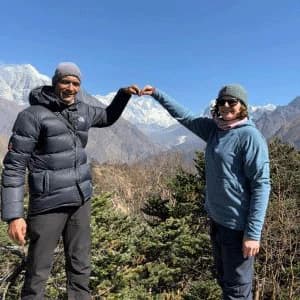
I completed the Everest Base Camp trek in November 2024. The world class customer service began right away as my in-bound flights from the US...

